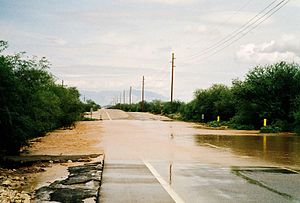The summer storm season is heating up in Arizona and New Mexico, which means increased risks from dangerously high temperatures, lightning, gusty winds and flash floods. During Monsoon Safety Awareness Week, the Insurance Institute for Business & Home Safety (IBHS) urged residents to learn more about these risks and ways to stay safe during monsoon season, which lasts through September 30. Since many of us are active during the summer months despite the Arizona heat, we need to be aware of the dangers and take necessary steps to keep safe during the potential floods and dangerous winds of monsoon season.
In Arizona and New Mexico, lightning strikes, high winds, wildfires, tornadoes, flash flooding and extreme heat have caused an average of 10 deaths and 60 injuries along with tens of millions of dollars of damage each year since 1995, the National Climatic Data Center reports.
During monsoon season, many residents also face the risk of uninsured property losses because they don’t have flood insurance, according to the Arizona Insurance Council (AIC).
“Flood insurance must be purchased separately from standard insurance policies,” says Nicole Farr, Communications Manager for the AIC. “Flood insurance is affordable and available to homeowners, renters and business owners through the National Flood Insurance Program.”
IBHS joins with the Arizona Insurance Council and the National Weather Service to offer this guidance to help reduce the risk of injury and property damage during monsoon season:
Flash Floods: Turn Around, Don’t Drown
- Most flash flood deaths occur in vehicles.
- Moving water 1 ft. – 2 ft. deep will carry away most vehicles.
- Find additional guidance for flash flood preparedness.
High Winds: Seek Shelter
- Thunderstorms frequently produce strong downward rushes of air, called microbursts or downbursts: These winds can gust in excess of 100 mph and cause extensive property damage. Learn how to prepare your property for high winds.
- If a microburst or downbursts is approaching, move inside and seek shelter in a sturdy area that is away from windows. Find more guidance to stay safe.
Lightning: Go Inside
- No place outside is safe from lightning during a thunderstorm.
- Lightning can strike up to 10 miles away from a storm. Find resources to protect your home and business from lightning damage.
- If you hear thunder, lightning is close enough to strike you.
- Move inside a strong building or an enclosed hardtop vehicle.
- Avoid contacting inside wiring and plumbing during a thunderstorm; this includes appliances and corded phones.
- Stay in shelter for 30 minutes after the last thunder.
Thunderstorms and Dust Storms: Stay Off the Roads
- Thunderstorms frequently produce strong downward rushes of air, called microbursts that spread out along the ground that spread dense blowing dust or haboobs.
- DO NOT drive in a dust storm.
- If you do get caught up in a dust storm while driving, avoid running into another vehicle and make your vehicle less likely to be hit:
- Pull off the road and put the vehicle in park
- Turn off the lights Take your foot off the brake pedal


